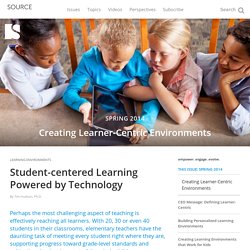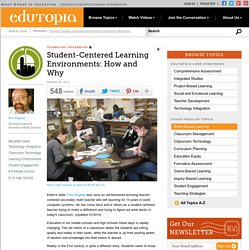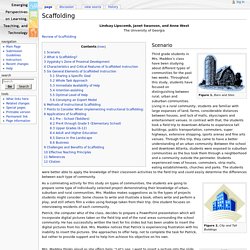

Student-centered Learning Powered by Technology. Perhaps the most challenging aspect of teaching is effectively reaching all learners.

With 20, 30 or even 40 students in their classrooms, elementary teachers have the daunting task of meeting every student right where they are, supporting progress toward grade-level standards and cultivating the development of the whole child. On a daily basis, teachers make student-centric decisions by providing remediation, grade-level work or enrichment as appropriate. But this requires significant amounts of time, resources, data and content-area expertise. So when a fourth grade student doesn’t understand second grade mathematics, teachers rarely have the time or opportunity to revisit foundational number concepts with her.
And with education funding cuts, the school may not have staffing resources to work with this student outside of class. Despite the challenges, dedicated teachers design and implement student-centered lessons to gain insight into what each child knows and understands. 6 Scaffolding Strategies to Use With Your Students. What’s the opposite of scaffolding a lesson? Saying to students, “Read this nine-page science article, write a detailed essay on the topic it explores, and turn it in by Wednesday.” Yikes! No safety net, no parachute—they’re just left to their own devices. Let’s start by agreeing that scaffolding a lesson and differentiating instruction are two different things. Scaffolding is breaking up the learning into chunks and providing a tool, or structure, with each chunk.
Simply put, scaffolding is what you do first with kids. Scaffolding and differentiation do have something in common, though. So let’s get to some scaffolding strategies you may or may not have tried yet. 1. How many of us say that we learn best by seeing something rather than hearing about it? Try a fishbowl activity, where a small group in the center is circled by the rest of the class; the group in the middle, or fishbowl, engages in an activity, modeling how it’s done for the larger group. 2. 3. 4. 5.
Teaching Strategies. Student-Centered Learning Environments: How and Why. Editor's Note: Paul Bogdan was once an old-fashioned lecturing teacher centered secondary math teacher who left teaching for 14 years to build computer systems.

He has come back and is reborn as a student-centered teacher trying to make a difference and trying to figure out what works in today's classroom. (Updated 01/2014) Education in our middle schools and high schools these days is rapidly changing. The old notion of a classroom where the students are sitting quietly and neatly in their seats, while the teacher is up front pouring pearls of wisdom and knowledge into their brains is absurd. Reality in the 21st century is quite a different story. Unfortunately, not all problems have easy solutions. The good news, however, is that not all students are so unaware. Are teachers obsolete? Do-it-yourself, student-to-student teaching, project-based learning, and student-centered learning environments are some of the more encouraging programs. Do It Yourself (DIY) Practical Tips for Designing a Student-Centered Lesson Plan. Scaffolding. Lindsay Lipscomb, Janet Swanson, and Anne West The University of Georgia Review of Scaffolding Scenario Figure 1.

Barn and Silos Third grade students in Mrs. Figure 2. As a culminating activity for this study on types of communities, the students are going to prepare some type of individually selected project demonstrating their knowledge of urban, suburban and rural communities. Patrick, the computer whiz of the class, decides to prepare a PowerPoint presentation which will incorporate digital pictures taken on the field trip and of the rural areas surrounding the school community. Figure 3. 5 Ways to Make Your Classroom Student-Centered. The power of student-driven learning: Shelley Wright at TEDxWestVancouverED. From the Teacher-Directed to the Student-Centered classroom.